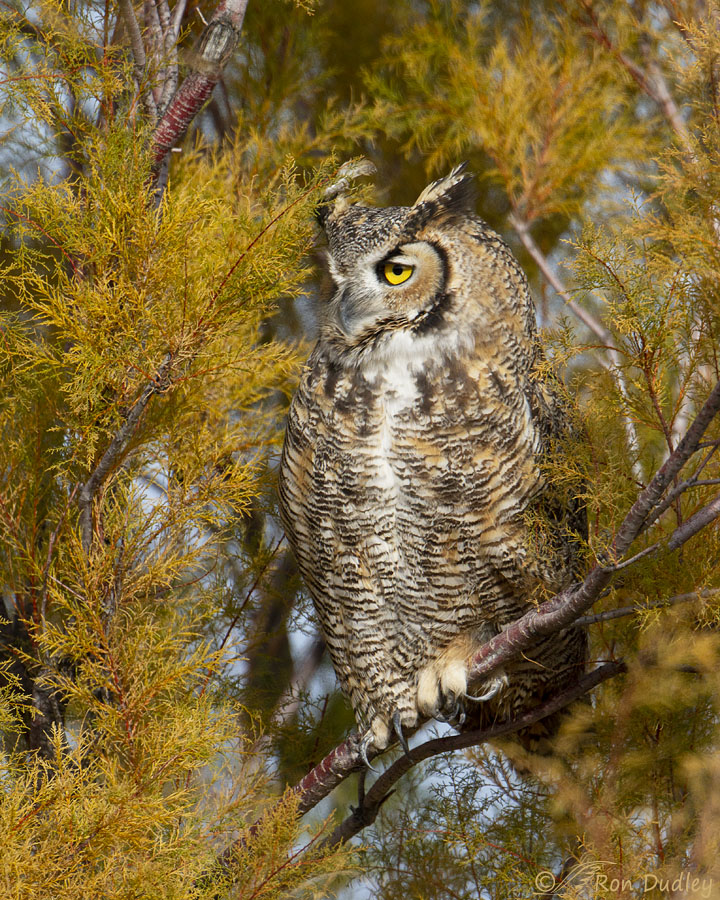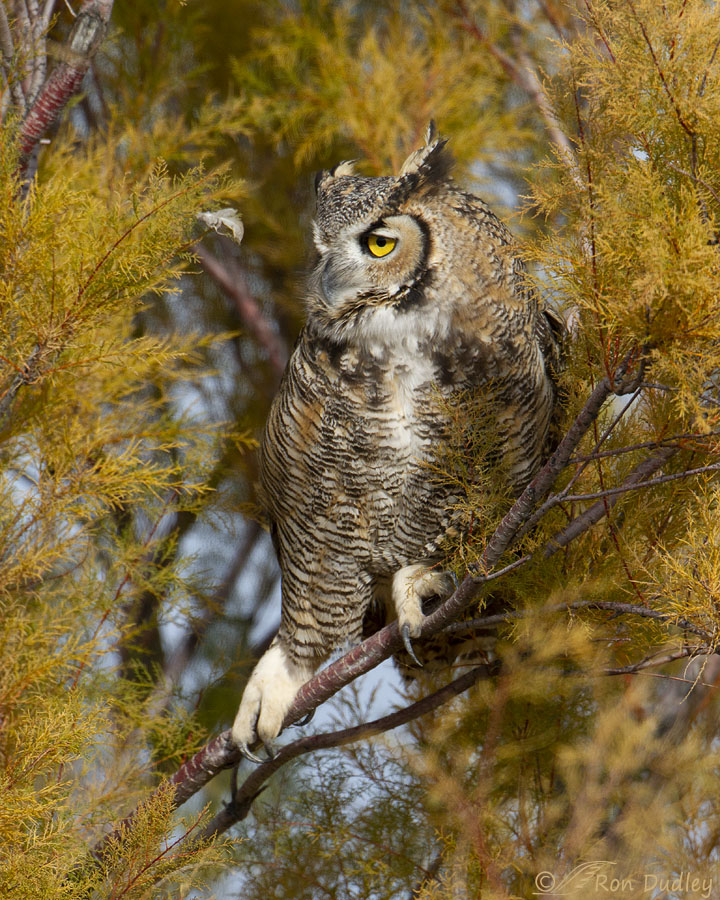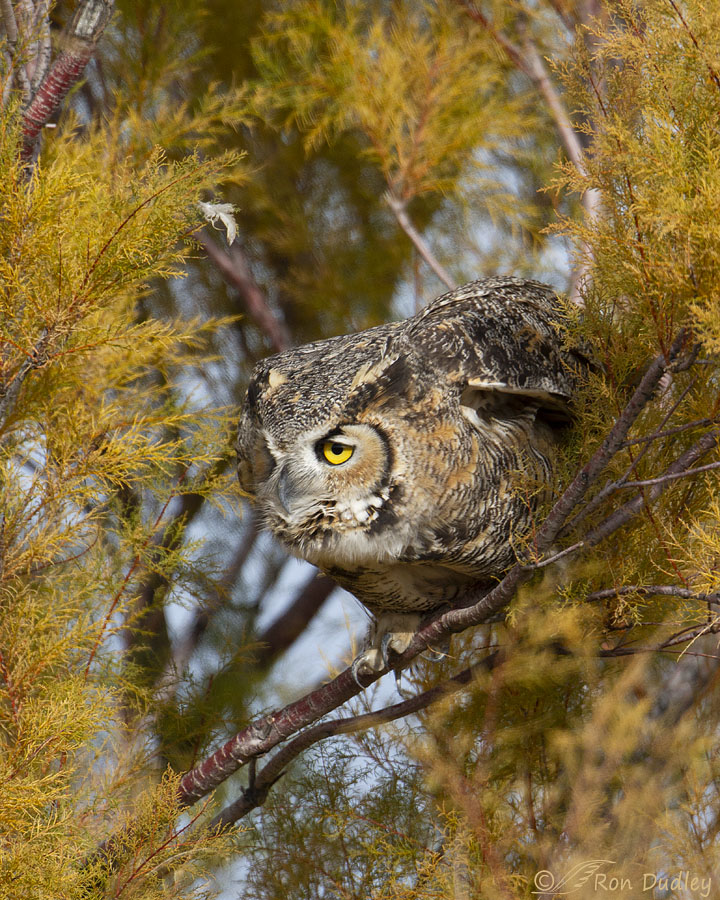Because birds are so fast, familiarity with their behaviors is a valuable tool for anticipating interesting photographable moments.

1/2500, f/6.3, ISO 400, Canon 7D, Canon EF 500mm f/4L IS II USM + EF 1.4 III Extender, not baited, set up or called in
Roughly ten years ago, when I was still a rank amateur at anticipating bird behaviors, I spent some time with this stately Great Horned Owl in a tamarisk on Antelope Island. Most of the time, when ‘he’ wasn’t obviously drowsy with his eyes half closed, he was looking straight forward or to his left. But after a while something to his right caught his attention and his posture became more erect.
Notice that to be able to see anything in the direction he was looking he had to be peering through tamarisk leaves and twigs. They were obviously between his face and whatever he was trying to look at.

1/2000, f/6.3, ISO 400, Canon 7D, Canon EF 500mm f/4L IS II USM + EF 1.4 III Extender, not baited, set up or called in
So, with his eyes still on whatever it was, he began to sidle up the steep branch that was his perch.
At the time I saw what he was doing but I wasn’t smart enough to put two and two together and realize that he was moving up the branch so he’d have a somewhat clearer path for takeoff through the branches in the direction he was looking, whether there was prey there or just a new perch he wanted to go to.

1/2000, f/6.3, ISO 400, Canon 7D, Canon EF 500mm f/4L IS II USM + EF 1.4 III Extender, not baited, set up or called in
And sure enough, very soon after he reached the highest point on the perch that had room for him, he took off in the direction he’d been looking.
At the time I knew I was too close for takeoff shots so they weren’t my goal (I got one but I butchered his wings). But it wasn’t until I reviewed my photos at home that I realized that if I’d been after takeoff shots I could have anticipated that he was about to take off when he sidled up the branch. So I stored that bit of field lore in my memory for future use and over the years it’s paid off more than once. Birds, especially large birds, need as clear a path as possible for their flailing wings during takeoff.
More generally, this encounter also helped to teach me to be on the lookout for any bird behavior that might signal an action I’d want to photograph. Pay attention, Bud!
Ron
Note:
For those who may be interested in repeat palindromes (numbers are repeated and they read the same forward and backward), these photos were taken on November 11, 2011 – 11/11/11. There was a similar repeat palindrome on 12/12/12 but there hasn’t been one since and the next one won’t occur until New Year’s Day, 2101 (01/01/01).
There’s nothing wrong with a little meaningless trivia now and then.


I love these “amateur” shots. I’m curious which award did you receive after which you knew you were no longer an amateur?
Elmer, I still consider myself an amateur. Or at least mostly an amateur.
Animals are such wonderful teachers! I learn something every time I work with one of the dogs at the shelter.
Your note got me to thinking (I learn something from you every time I read your blog), and we do have one digitally palindromic, though not repeating, date coming up in a couple of weeks: 12/11/21
Thanks, Marty and you’re right about learning from critters.
Regular old palindromes happen much more frequently than repeat palindromes.
Your comment that “Most of the time, when ‘he’ wasn’t obviously drowsy with his eyes half closed…”, combined with the glowing tamarisk that seems to wonderfully reflect on his feathers brings to mind “Golden slumbers”, both the Paul McCartney song and Thomas Dekker’s poem.
I guess I’m only familiar with McCartney’s song, which I quite like.
Love the colours, the action “series”, the commentary and the behavioral lessons. I would however like to be an “amateur” with photos like this in my portfolio. If you ever come across behavioural “tells” which could help me predict the flight paths of the backyard chickadees to which I am limited . . . 😉
Ha, tracking songbirds in flight is nearly an impossible task, Granny Pat. They’re just too small, fast and erratic. It’s easiest to get them in flight right after they’ve taken off but even that is tough as the dickens.
Yes knowing how your prey behaves is helpful even for the photographer.
From the size of those feet I think you have a girl. Very nice series, I love the colors.
Thanks, April.
Yes – when they sidle up a branch it is a sure sign of an imminent takeoff that you learned and I learned over time. Took me longer than it should have to learn that though.
Really like the colors in these photos. Look at the strength in those feet and talons. Once he grabs hold of something it is done.
Agreed, Everett. I really like the color palette in these shots.
Fabulous GHO shots!
Thank you, Sallie.
Like Terri those feet/talons drew my eye. What a magnificent bird. And how generous of it to teach you a valuable lesson AND give you some stunning shots first.
I firmly believe that watching/anticipating behaviour helps with every interaction with a living thing. Our own species included.
Good point about our own species, EC.
A reframe. A wonderful series showing the pre take off ritual – stillness, glare, re positioning, hunching down – and then ….
Ron, can you buy this?
“Ron, can you buy this?”
Buy what? A print?
Magnificent! Very useful lesson 😄
Thank you, Kathleen.
Wonderful shots of the GHO – 🙂 Of course, I’m partial to them. 😉 Yes, learning to “read” the birds (or most any critter) makes for better viewing AND photography…… 🙂
Judy, I wish I had reliable access to GHO’s like you do. If I remember correctly, you have resident owls in the trees in your yard.
Haven’t had them for a few years now tho they are in the vicinity. A pair has been in/out of the yard lately so we’re hopeful…….. They are the ones with the “different voices” – suspect injuries from a hail storm a few years back that took out at least 4 near here. Shortage of Magpie nests may be an issue as there have been fewer of them in the yard the past couple of years since more Grackles have showed up.
Thankfully the resident owls on the family farm are still there. And have been for about 15 years now. Or longer.
Wonderful story about wisening-up, and wow, those talons!
Thanks, Terri. Pretty impressive aren’t they.